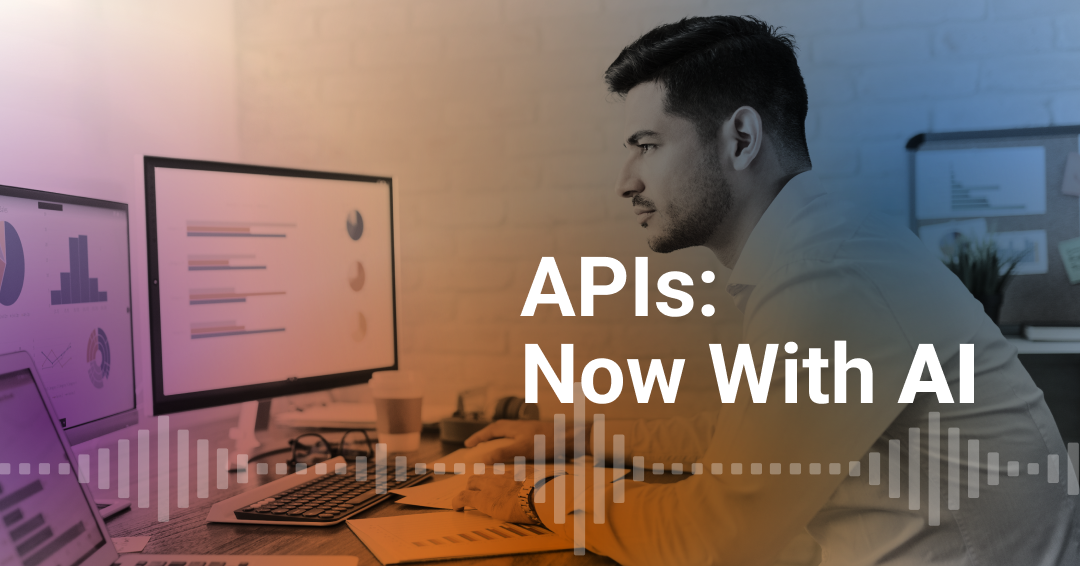The Strategic Role of Analytics Dashboards in Call Centers
When customers call, they want to be heard now, not wait. However, if there's no visibility into what's happening across queues, agents, and...
Application Programming Interfaces (APIs) have become a vital part of software development, allowing different applications to communicate with each other. AI-powered APIs, also known as AI APIs or AI-based APIs, are transforming the world of API design and opening up new possibilities for developers.
In this blog post, we’ll explore the growing role of AI in APIs and how AI is changing the API landscape. We’ll look at what AI APIs are, their benefits, use cases, challenges, and the future outlook for AI in API development.
Unlike standard APIs that allow applications to merely exchange data, AI-driven APIs utilize machine learning and natural language processing to provide advanced capabilities such as understanding requests, providing relevant responses, and performing tasks.
Imagine a standard weather API that typically returns weather information for a location. But by using an AI weather API, it can interpret more complex requests. For example, requesting "Will this weekend be sunny in San Francisco?" and getting a natural language reply.
As for how AI API integration actually works, you use specific endpoints to connect your application to external AI services. The process typically follows these steps:
Consider OpenAI's GPT API. When you send a text prompt, the API processes your request through large language models and returns generated text. The integration requires a few lines of code to connect your application to this powerful AI capability.
Hence, without the need to understand or write any code, non-technical users can use AI API platforms to connect their AI services. This is its biggest benefit.
AI-based APIs process information in a human-like manner, making them pretty advantageous over traditional programming interfaces. Here's how:
The biggest benefit is removing technical barriers for non-technical users. Instead of using structured commands or precise queries, you can ask questions using everyday language. An AI API will understand what you’re asking and give a relevant response.
AI APIs analyze user intent and provide tailored results based on the specific situation. When you ask "How's the weather?" a traditional API returns raw data. An AI weather API considers your location, time of day, and personal preferences to respond with "It's 72°F and sunny, perfect for your morning jog." This contextual understanding makes interactions more relevant and useful.
These APIs improve their performance as they process more requests and gather feedback. Machine learning models within the API analyze patterns in user interactions and refine their responses accordingly. Hence, making a note of what works and what doesn’t. Google's search API continuously learns from billions of queries to provide better results.
AI APIs automate tasks that previously required human intervention. Content categorization, data extraction, and document processing happen automatically.
Financial institutions, as one clear example, use AI APIs to detect fraudulent transactions by analyzing spending patterns in real-time. The same process would otherwise take a significant amount of resources and time.
AI-based APIs open doors to several advanced capabilities like being able to predict events, make recommendations, and analyze sentiments. These technologies would be nearly impossible to build with traditional programming, considering their level of complexity and the resources needed.
Ever noticed Netflix making a solid recommendation? That’s its API in action, analyzing your viewing habits to suggest content.
AI models within APIs can process massive numbers of requests simultaneously without performance degradation. The AI handles the heavy lifting, allowing the API to serve thousands of users concurrently. Twitter's API can analyze sentiment across millions of tweets in minutes, while traditional text processing would take hours.
AI APIs deliver uniform responses regardless of who makes the request or when it's made. The same input produces the same output every time, ensuring reliable results across different users and timeframes. This predictability is crucial for business applications where consistent data interpretation matters.
AI APIs create opportunities that didn't exist with traditional programming interfaces. Conversational chatbots can now be easily created to handle complex customer service scenarios. Image recognition APIs are being used to instantly identify objects, people, or text in photos.
Language translation APIs, one of the most useful use cases here, provide real-time communication across language barriers. These capabilities open new markets and use cases that were previously impossible or impractical to implement.
The market offers hundreds of options when it comes to API models, and most of them are good as well. Your choice, however, should always depend on your specific requirements or what you want to achieve. This is because selecting the right AI API can make or break your project.
For instance, enterprise customers often prioritize reliability and support, while content creators might value speed over precision. Financial firms need maximum accuracy to boost their fraud detection, while an e-commerce chain will prefer to prioritize image recognition.
The API should deliver precise results consistently. For text analysis, this means correctly identifying sentiment, intent, or key information. Image recognition APIs need to identify objects, faces, or text with minimal false positives.
Google's Natural Language API maintains 70-80% accuracy for sentiment analysis across different languages.
Uptime and consistent performance matter for production applications. The best AI APIs, like AWS and Microsoft Azure, guarantee stable uptime and response even during peak usage. Hence, look for APIs with redundant infrastructure and clear incident response procedures.
Pricing should always be an important factor when choosing your API. Some APIs charge per request, others by data volume or processing time. Depending on your usage patterns and budget, it's important to filter out unsuitable options early in the selection process.
Documentation quality and SDK availability determine how quickly you can implement the API. Well-designed APIs provide clear code examples, comprehensive guides, and libraries for popular programming languages.
Going for APIs with complex authentication or unusual data formats only slows down development.
Technical support helps resolve issues quickly when problems arise. Enterprise-grade APIs offer dedicated support channels, while free tiers might only provide community forums.
Review response times and available support channels before committing to an API for critical applications.
Businesses across industries are now using AI APIs to automate routine tasks, personalize experiences, and provide 24/7 support. Imagine detecting fraud in milliseconds, and that too by an automated workflow that's working around the clock.
These smart interfaces are quickly helping companies meet their customer expectations while gaining a competitive edge in the market. Here are some use cases where AI API integration helps enhance applications:
Natural language processing and machine learning combine to power intelligent virtual assistants (IVAs) that handle customer inquiries through chat, voice, or messaging platforms. These agents understand context, maintain conversation history, and can even escalate complex issues to human representatives.
Bank of America's Erica assists millions of customers with account questions and transactions. It’s become core to the bank’s digital banking experience.
AI APIs analyze customer behavior and preferences to suggest relevant products or content. Pretty much every digital platform uses this tech to increase its customer engagement and average conversion. Spotify's API, as one example, creates personalized playlists based on your listening habits and music preferences.
We're now moving into more advanced use cases of AI-based API integration. These systems examine text or voice data to identify emotional tone and customer satisfaction levels. They can catch nuances that would otherwise go unnoticed.
It's highly beneficial for customer service teams because they can use sentiment APIs to flag frustrated customers and prioritize their cases.
AI search APIs understand the intent behind customer queries and return relevant results even with incomplete or unclear requests. These APIs handle typos, synonyms, and natural language questions that would confuse traditional keyword-based search. Even better. These systems learn from every user interaction to become smarter over time.
Automated content creation APIs help customer service teams respond faster and more consistently. Many retail outlets are using the tech to generate their product descriptions, email responses, and FAQ answers, while maintaining their brand voice.
Machine learning APIs analyze historical data to forecast future outcomes and customer behavior. These predictions help businesses allocate resources and identify opportunities proactively.
Taking insurance companies as an example, they can use predictive APIs to assess risk and price policies, making their workflows far more efficient than normal.
AI APIs are exceptionally good at monitoring transactions and user behavior to identify suspicious patterns before they impact customers. Banks use them to detect unusual spending patterns, while online marketplaces scan listings for fake products and suspicious seller behavior.
Optical character recognition and natural language processing APIs extract structured information from documents and forms. Healthcare providers, as a common example, extract patient information from medical records and insurance forms. These APIs reduce manual data entry and minimize human error.
Translation APIs break down language barriers by converting text or speech between languages in seconds. Google Translate API is a popular example here. It handles real-time chat for global support teams without the need to hire or train local staff.
Adding AI to your API infrastructure presents several practical hurdles. These can range from severe financial barriers to complex technical requirements. Understanding these challenges beforehand is how companies can plan their AI implementation better.
This shouldn't be surprising. Every infrastructure requires a significant upfront cost. For AI APIs, this investment pool needs to account for model training, collecting and storing information, skilled personnel, etc.
Cloud-based AI services are an excellent option to reduce these initial expenses, especially for smaller businesses. However, enterprises will likely require customer solutions that come with a sizable investment requirement.
AI systems run on complex algorithms and mathematical models that require specialized knowledge. Your development team needs expertise in machine learning, data science, and statistical analysis.
Understanding how neural networks process information or how different algorithms handle specific tasks takes time and training. Many companies struggle to find developers with the right combination of API development and AI skills.
When your API returns unexpected results, troubleshooting becomes difficult because you can't trace exactly how the AI reached its conclusion. This makes it harder to debug issues or verify if the system works correctly across different scenarios.
It's common for bias to seep into AI models through their training data. Consider for a moment that your historical data shows biased hiring practices against underrepresented backgrounds. Based on this, your hiring AI model may reject such candidates even if they are highly qualified.
Your AI performs based on the quality and quantity of its training data. Hence, you need large, diverse datasets that accurately represent the problems you want to solve. Missing or outdated information ends up compromising your AI models, making it an ongoing effort to maintain high-quality datasets.
AI systems need constant attention to perform well over time. You must monitor performance metrics, update algorithms, and adjust parameters based on usage patterns. This maintenance goes beyond typical software updates. It involves understanding when model performance drops and knowing how to fix it.
You need to ensure your AI systems comply with data protection laws and fairness standards. Some business sectors face specific regulations about AI decision-making, while others require you to explain how automated systems reach conclusions. Staying compliant means tracking changing regulations and implementing appropriate controls.
AI APIs help businesses automate tasks, process data faster, and build smarter applications without developing machine learning capabilities from scratch. These tools handle everything from customer service conversations to document analysis, giving companies access to advanced AI features through simple integrations. Here are the top AI APIs that deliver practical results for businesses looking to improve operations and accelerate growth.
Mosaicx leads the pack with its advanced conversational AI platform, handling customer interactions through human-like natural dialogues and responses. Its IVAs are designed to automate customer service without requiring the involvement of any human agents.
The API connects directly to existing business systems and provides detailed interaction analytics. Companies use Mosaicx to manage high call volumes, reduce response times, and maintain consistent service quality. The platform includes security features that meet enterprise compliance requirements.
Mosaicx fits businesses that handle large-scale customer support operations and want to reduce the manual workload on their support teams while maintaining conversation quality.
OpenAI's API is hailed for its powerful language models like GPT-4. You can integrate them to generate meaningful content, summarize text, provide translations, and more. Its versatility makes it suitable for applications ranging from chatbots to research tools.
Google Cloud offers a rich suite of AI APIs, including Vertex AI, Vision AI, and Natural Language AI. These tools power everything from customer sentiment analysis to document parsing and predictive analytics. Google’s models are pre-trained on vast data, ensuring high accuracy and enterprise-grade reliability.
AWS provides multiple AI services that handle different business needs. Amazon Rekognition analyzes images and videos to identify objects, people, and activities. Amazon Comprehend processes text to extract insights, sentiment, and key information. Amazon Lex builds chatbots and voice interfaces for customer interactions.
These services scale automatically based on usage and connect directly with other AWS tools like databases and storage systems. Companies already using AWS infrastructure can add AI capabilities without major platform changes.
Microsoft Azure offers AI APIs across four main categories: vision, speech, language, and decision-making. Computer Vision analyzes images to identify objects and read text. Speech services convert audio to text and text to speech in multiple languages. Text Analytics processes written content to determine sentiment and extract key phrases.
These APIs work together within the Azure ecosystem, allowing businesses to combine different AI functions in single applications. Companies using Microsoft tools can add AI features to existing workflows without switching platforms.
Anthropic’s Claude API offers a conversational AI built with safety at its core. It excels in nuanced dialogue, deep reasoning, and thoughtful interaction design, making it a popular choice for enterprise-level AI adoption with a focus on ethical AI.
Hugging Face provides an extensive collection of pre-trained models for NLP, computer vision, speech, and more. It's an ideal library for developers who want flexibility and access to community-driven AI.
AI is moving from abstract systems to packaged tools that businesses can use without training a model from scratch, all thanks to APIs. This shift makes it easier to build AI into daily workflows. It also means changes happen faster. Here’s what’s likely to happen next:
Pre-built AI models are becoming easier to access. More platforms now offer plug-and-play services that don’t require deep technical knowledge. At Mosaicx, we expect pre-built models to shape much of how we deliver customer interactions going forward.
Text and voice aren't the only inputs anymore. APIs are starting to read and respond to images, video, sensor data, and digital environments. This will expand how users interact with machines.
General tools won’t cut it for every job. More vendors are building AI features tuned to specific industries: healthcare, finance, retail, and utilities. This shift allows companies to adopt tools without heavy customization.
AI tools will stop acting as standalone services. APIs will combine multiple functions like language, vision, and analytics into a single workflow, reducing handoffs between systems.
Companies are being asked to show how their AI works. That includes tracking where data comes from, how decisions are made, and how bias is handled. Trust is no longer optional.
Instead of relying on one method, developers are blending different systems, like rule-based logic with statistical models, to handle tasks better. This mix helps cover gaps that one approach can’t solve alone.
Governments are stepping in. Expect more rules about how AI is built, tested, and used. This includes standards around fairness, consent, and accountability. Businesses will need to adjust as these rules evolve.
The convergence of AI and API technology opens up new possibilities for building intelligent, conversational interfaces between applications. AI APIs utilize natural language processing, machine learning, and other AI techniques to provide dynamic responses and advanced capabilities that mirror human cognition.
While traditional APIs exchange static data, AI enriches APIs with contextual interaction, automation, and sophistication at scale. Developers can now rapidly tap into AI services to create bots, recommendation engines, predictive analytics, and other functionality that was previously time-consuming or unachievable.
However, AI adoption does not come without challenges. Thoughtful preparation is required to handle technical complexity, avoid bias, ensure transparency, and maintain rigorous testing. By starting with well-defined use cases and moving incrementally, companies can overcome these hurdles to realize the multitude of benefits.
As AI APIs continue proliferating across industries, they will fundamentally reshape how humans and machines interact. More natural interfaces like voice, vision, and language will dominate.
The possibilities look limitless as APIs become the new driveways for AI to steer developments and enhance customer experiences across the digital landscape. To see what's likely to change first, check out how AI will change customer service and contact centers in 2025 and beyond.
.png)
When customers call, they want to be heard now, not wait. However, if there's no visibility into what's happening across queues, agents, and...

Every call is another opportunity for contact centers to gather important data on their customers. That data can reveal preferences, where customers...

Enterprises can't afford to manage their customer conversations with tools that were never designed for scale. One bad interaction is all it takes to...
